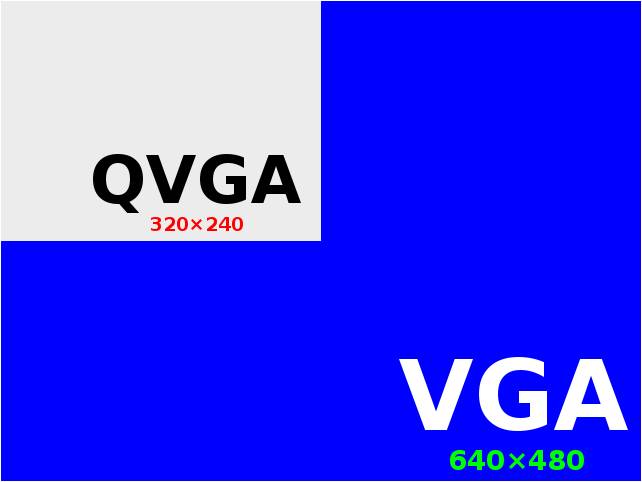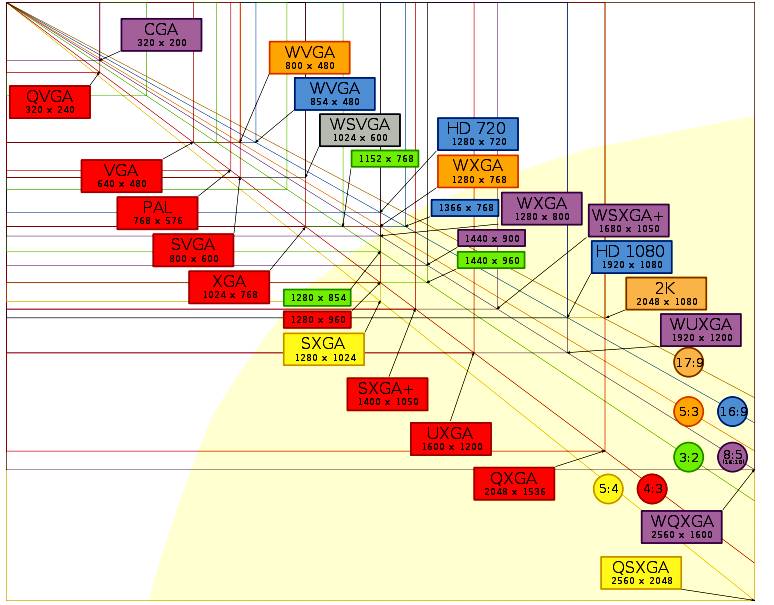TFT LCD
| Inteltronic offers a range of standard TFT LCD modules for your development. Some of our standard items also has touch panels available. See our TFT LCD module list. And TFT LCD with integrated resistive touch list. And TFT LCD with capacitive touch panels. Inteltronic TFT LCDs for your projects:a |
||||
| *Upward compatibility *High luminance up to 1500 nits *Wide viewing angle up to 170 degree *High color saturation displays *Long life LED backlight *Ultra-Thin small size displays *Wide temperature range *RoHS compliant *Touch panels available *Various interface definitions [email protected] |
 |
|||
Inteltronic TFT module Tool set available:
Inteltronic LCD evaluation kit set is a simple plug and play solution that provides you with everything you need to start with.
*The TFT-LCD display panel
*TFT controller board with on-screen display
*A backlight Inverter board/ LED driver board
*DC power supply and AC line cord
*SVGA (analog RGB) cable
*DVI (digital input) cable
*Video input cable
[email protected]
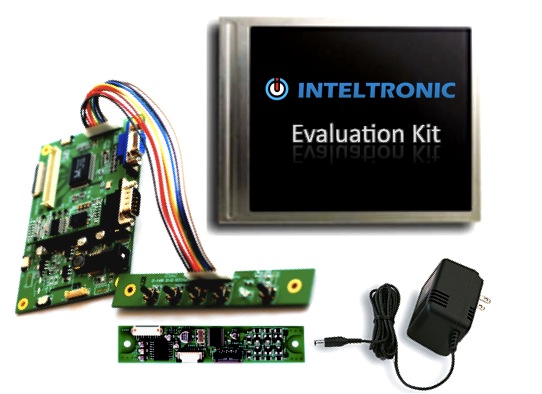
What is a TFT?
a
Thin film transistor liquid crystal display (TFT-LCD) is a variant of a Liquid Crystal Display (LCD) which uses thin-film-transistor (TFT) technology to improve image quality (e.g., addressability, contrast, brightness). TFT LCD is one type of an active matrix LCD, though all LCD-screens are based on TFT active matrix addressing. TFT LCDs are used in industrial, commercial, medical, military, automotive, gaming and consumer applications around the world.a
a
Construction
a
A TFT display is comprised of a large number of picture elements called pixels. Since it would require millions of connections – top and bottom connections for each one of the three colors (red, green and blue) of every pixel. To avoid this issue, the pixels are addressed in rows and columns, reducing the connection count from millions to thousands. The column and row wires attach to transistor switches, one for each pixel. The one-way current passing characteristic of the transistor prevents the charge applied to the pixel from draining between refreshes to the display image. Each pixel is a small capacitor with a layer of insulating liquid crystal sandwiched between transparent conductive ITO layers.
a
a
Subpixels of a colour LCD
In colour LCDs ecah individual pixel is divided into three cells, or subpixels, which are cloured red, green, and blue, respectively, by additional filters (pigment filters, dye filters and metal oxide filters). Each subpixel can be controlled independently to yield throusands or millions of possible colours for each pixel.
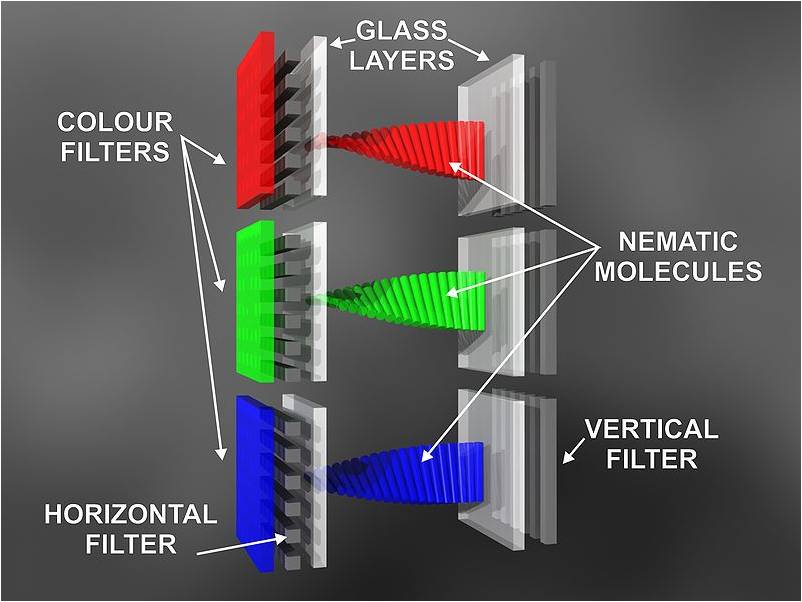
Example of how the colours are generated (R-red, G-Green and B-blue)
LCD screen close up showing how colours are made on a white background. R is seen red, G green and B blue. The letter R has the blue and green elements off and the red on, resulting the Red colour. The white backgroud is a result of all colours on.
a
a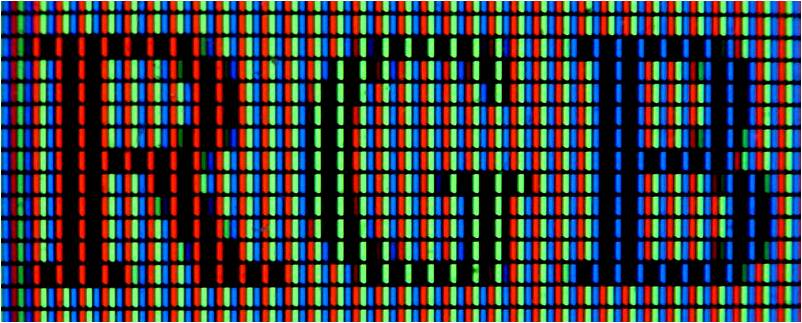
a
a
Macro photograph showing subpixels in detail
a
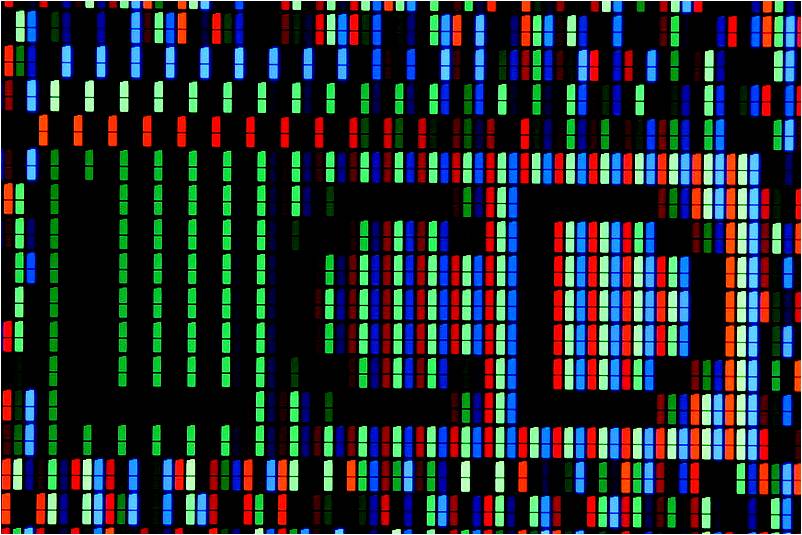
a
a
Resolution
a
There are many different active matrix displays on the market. Each display is associated with a specific physical display resolution. The display resolution signifies the number of dots (pixels) on the entire screen. The higher the resolution, the more dots or pixels on your display device. The total number of pixels in an active matrix display is fixed.
a
Monitor
Resolution
Monitor
Resolution
QVGA (quarter-video graphics array)
320 × 240
SXGA (super extended graphics array)
1280 × 1024
VGA (video graphics array)
640 × 480
SXGA+ (super extended graphics array +)
1400 × 1050
WVGA (wide video graphics array)
800 × 480
UXGA (ultra extended graphics array)
1600 × 1200
SVGA (super video graphics array)
800 × 600
WSXGA+ (wide super extended graphics array +)
1680 × 1050
XGA (extended graphics array)
1024 × 768
WUXGA (wide ultra extended graphics array)
1920 × 1200
WXGA (wide extended graphics array)
1280 × 800
WQXGA (wide quad extended graphics array)
2560 × 1600
WXGA+ (wide extended graphics array +)
1440 × 900
a
a
a
a
Glossary of Terms
- active area/effective area: In the viewing area of the LCD glass, the dimensions of the perimeter of the conductive area.
- active matrix display: A type of display using thin-film transistors (TFT) to individually control each pixel. Active matrix displays offer higher contrast ratios, wider viewing angles, and faster response times than passive matrix displays.
- aperture ratio: The ratio of the actual light-transmitting area to the theoretical sub-pixel size calculated based on active area and resolution.
- aspect ratio: The ratio of width to height. When an image is displayed on different screens, the aspect ratio must be kept the same to avoid 'stretching' in either the vertical or horizontal direction. Aspect ratios are typically 4:3 and 16:9 (or 16:10) for monitors and high-definition televisions (HDTV) respectively.
- backlight: Some LCD displays are illuminated by the use of separate light sources or backlights that are built into the unit behind the LCD panel.
- bezel: A frame of plastic or metal that fits around the LCD glass screen to protect the edges of the glass, provide electro static discharge (ESD) and reinforce the LCD panel structure.
- brightness: The attribute of visual perception in accordance with which an area appears to emit more or less light. (Luminance is the recommended name for the photo-electric quantity which has also been called brightness.)
- CCFL (cold cathode fluorescent lamp): A type of fluorescent backlighting or edge lighting.
- cell gap: The space containing liquid crystal fluid between the two pieces of glass.
- COG (chip on glass): A new technology wherein an LCD driver is mounted on the contact edge of the LCD glass substrate.
- contrast ratio: The ratio of the luminosity of the brightest and the darkest color a display is capable of producing.
- color saturation: A measure of a color's purity. A highly saturated color appears much more vivid than a less saturated color.
- color temperature: Measured in degrees Kelvin, color temperature is a reference providing a standard for defining standard colors emitted from computer displays. 6500K is close to the European TV standard and close to the white color under the sun at noon.
- cross talk: A phenomenon occurring when voltage leaks from an energized element to an adjacent OFF element and turns the adjacent element partially ON, making them slightly visible.
- DVI (Digital Visual Interface): A digital flat panel interface introduced by the Digital Display Working Group (DDWG). Although other interfaces have been introduced, DVI is expected to become the industry standard.
- DDC (display data channel): A communication channel for the transmission of information between a display monitor and a PC that allows for automatic configuration of the hardware. In other words, "Plug and Play" compatibility.
- dot clock/dot frequency: The frequency with which dots (or pixels) are illuminated on the screen; how quickly a single dot can be produced on the screen. A general formula for calculating dot frequency is: H x V x refresh-rate x 1.25 (to 1.3).
- dot pitch: The distance between one pixel to an adjacent pixel (not sub pixel). Dot pitch gives a general idea of a display panel's ability to produce sharp images.
- gray level (GL): Level of brightness for each color. Currently, 8-bit-depth driver IC can perform 28=256 levels of brightness for each color, Red, Green and Blue. The total colors of 8-bit-depth driver IC is 256*256*256=16.77M colors.
- gray-to-gray response time: The switching time between any two gray levels except 0GL to 255GL or 255GL to 0GL.
- ghosting: Refer to "cross talk".
- HDTV (High Definition Television): A new digital television broadcasting system available in several standard resolutions, all of which are higher than traditional formats (NTSC, SECAM and PAL). The video aspect ratio of the HDTV is 16:9, and audio specification of HDTV is Dolby Digital (AC-3).
- HRP (High Resolution Process): A technology that improves the optical transmission ratio and realizes very high resolution with ultra fine pitch by applying poly-film to the TFT array.
- inverter: Converts direct current (DC) to alternating current (AC) power at a high frequency and voltage, and is also used to power fluorescent lamps.
- IPS (In-Plane Switching): Developed to improve viewing angles and color reproduction of TN panels. Single domain IPS has slight color shifting at certain viewing angles, whereas dual domain IPS has less color shifting.
- lifetime: A term related to the issue of display brightness (CRT, LCD, and PDP) decreasing with age. Display lifetime is defined as the time that the brightness of the display decays to half of the original state.
- LCD (Liquid Crystal Display): A glass panel display that electronically controls the light passing through it using a liquid crystal medium.
- LVDS (Low Voltage Differential Signaling): An electrical signaling system that runs at very high speeds over twisted-pair copper cables.
- LGP (Light Guide Plate): Converts a line-shape light source to a uniform plane-shape light source.
- module: An LCD panel that includes a PCB, driver electronics, bezel, and possibly a backlight.
- MVA (Multi-domain Vertical Alignment): A type of liquid crystal which aligns vertically in the voltage-off state and where the liquid crystal molecules are arranged in multiple orientations.
- NTSC: The analog television system used in the United States, Canada, Taiwan, Japan, South Korea, the Philippines and some other countries, mostly in the Americas. Named for the National Television System(s) Committee, the U.S. standardization body that adopted it, NTSC standard has an aspect ratio of 4:3 and a resolution 720*480.
- ODF (One Drop Fill): In the traditional liquid crystal injection method, the cell is vacuum-filled through a capillary effect after two glass substrates are assembled. The ODF method drops the liquid crystal directly on the glass substrate prior to the assembling of the two substrates.
- outline dimensions: The dimensions of the display module including length, width and thickness.
- Omni-View Plus TM: A trademark owned by Honeywell and used in display applications featuring high-definition color and wide viewing angle.
- PDP (Plasma Display Panel): A type of flat panel display (also known as a "gas discharge display") now commonly used for large TV displays (typically above 32"). Cells located between two panels of glass hold an inert mixture of noble gases (neon and xenon), which is electrically charged to ionize and form a plasma; as the gas ions rush to the electrodes and collide, photons are emitted.
- polarizer: A stretched polymer which transmits light on only one axis. A typical display has polarizers on the front and the back.
- power consumption: Usually measured in Watts. An index is used to judge the power saving ability of a device.
- refresh rate: The frequency with which the entire image on the screen is redrawn. The refresh rate is measured in hertz, therefore, a refresh rate of 60 Hz, means the image is redrawn 60 times per second.
- resolution: Refers to the number of distinct pixels in each dimension that can be displayed or the physical number of columns and rows of pixels creating the display.
- response time: The amount of time a pixel in a display takes to go from 10% (on) to 90% (on) or 90% (off) to 10% (off) of brightness. Lower numbers mean faster transitions and therefore fewer visible image artifacts.
- RGB (Red, Green, Blue): The three colors represented as subpixels in LCD technology to compose any color.
- sRGB: A color space defined by Microsoft and Hewlett-Packard with the aim of color matching between applications and hardware devices such as monitors, scanners, printers, and digital cameras.
- TAB (Tape Automated Bonding): A process wherein the LCD driver or controller electronics are encapsulated in a thin, film like package, with metal leads extension from the IC chips.
- TFT (Thin Film Transistor): A type of LCD flat-panel display screen, in which each pixel is controlled by one to four transistors. TFT technology provides the best resolution of all the current flat-panel technologies. TFT screens are sometimes called active-matrix LCDs.
- Twisted Nematic (TN): A type of liquid crystal where the alignment surface, and therefore the liquid crystal molecules, is oriented 90 degrees from each surface of glass.
- VAextreme: Refers to a type of LCD panel integrating "Omniview" technology- to provide ultra low color shift.
- viewing angle: A cone perpendicular to the LCD in which minimum contrast can be seen.
- WOA (Wire on Array): Acts as an FPC (Flexible Printed Circuit) for connecting X and Y data information. The weight and cost of LCD module has been further reduced through the use of WOA and COG.
The circuit layout process of a TFT-LCD is very similar to that of semiconductor products. However, rather than fabricating the transistors from silicon formed into a crystalline silicon wafer, they are made from a thin film of amorphous silicon deposited on a glass panel. The silicon layer for TFT-LCDs is typically deposited using the PECVD process. Transistors take up only a small fraction of the area of each pixel; the rest of the silicon film is etched away to allow light to pass through.
Structure
Color TFT LCD Structure
Diagram of a pixel layout
1. Glass plates
2. Horizontal polarizer
3. Vertical polarizer
4. RGB colour mask
5. Horizontal command lines
6. Vertical command lines
7. Rugged polymer layer
8. Spacers
9. Thin film transistors
10. Front electrode
11. Rear electrode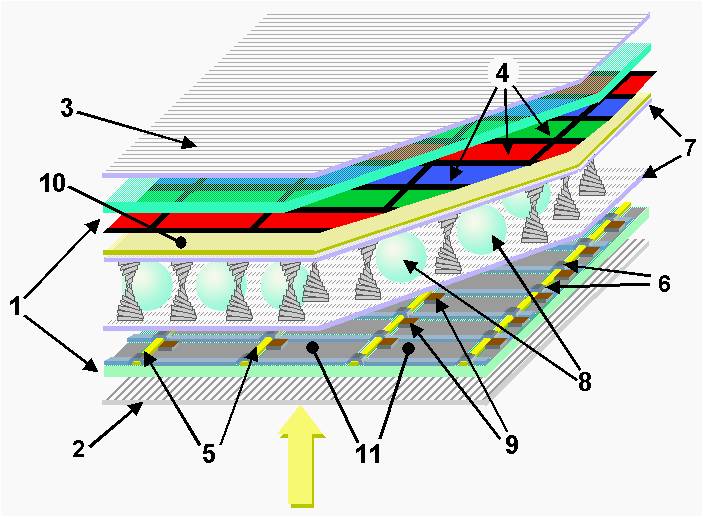
10. Front electrode
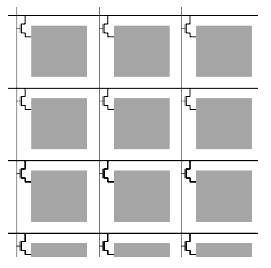
a







